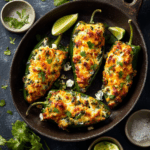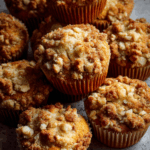Gulkand Stuffed Modak is a delightful fusion of traditional Indian sweet dumplings filled with fragrant, rose petal jam (gulkand). This recipe transforms the classic modak by infusing it with a floral sweetness that’s both refreshing and indulgent. Often prepared during festivals like Ganesh Chaturthi, modaks symbolize good fortune and joy. The soft, steamed outer shell made from rice flour envelops a luscious gulkand filling, making these treats both visually appealing and deliciously aromatic—a trendy twist on a beloved classic.
FULL RECIPE
Ingredients
- 1 cup rice flour
- 1 cup water
- 1 tablespoon ghee (clarified butter)
- A pinch of salt
- ½ cup gulkand (rose petal jam)
- 1 tablespoon chopped nuts (cashews, almonds, pistachios)
- 1 teaspoon poppy seeds (optional)
- 1 teaspoon cardamom powder
- Extra ghee or oil for greasing
Directions
- In a saucepan, bring water, ghee, and salt to a boil.
- Reduce the heat and gradually add rice flour, stirring continuously to avoid lumps, until it forms a smooth dough.
- Cover the dough and let it rest for 10 minutes.
- In a bowl, mix gulkand, chopped nuts, poppy seeds, and cardamom powder to make the filling.
- Grease your hands with ghee and divide the dough into small equal portions.
- Roll each portion into a ball, then flatten into a small disc.
- Place a teaspoon of filling in the center of the disc.
- Carefully fold and pleat the edges to seal the modak shape, pinching the top to form a peak.
- Repeat with remaining dough and filling.
- Grease a steamer plate and place modaks on it, leaving space between them.
- Steam for 10-12 minutes until the modaks turn slightly translucent and are cooked through.
- Remove and let them cool slightly before serving.
Nutrition Facts
- Calories: 220
- Total Fat: 7g
- Saturated Fat: 4g
- Cholesterol: 15mg
- Sodium: 10mg
- Total Carbohydrates: 38g
- Dietary Fiber: 1g
- Sugars: 18g
- Protein: 3g
The Cultural Significance of Modak
Modak holds a special place in Indian culture, especially in the context of festivals such as Ganesh Chaturthi, where it is offered to Lord Ganesha as a symbol of devotion and prosperity. Traditionally made with coconut and jaggery, modak signifies sweetness and fulfillment in life. The gulkand stuffed modak adds a modern, floral twist to this age-old favorite, blending tradition with contemporary flavors that appeal to newer generations while preserving the essence of this auspicious sweet.
Understanding Gulkand and Its Role in the Recipe
Gulkand, a sweet preserve made from rose petals and sugar, is prized for its unique floral aroma and subtle sweetness. In this recipe, it serves as the flavorful filling that elevates the modak beyond the ordinary. Its cooling properties and delicate fragrance create a sensory experience that complements the soft, chewy rice flour dough. Gulkand also has mild digestive benefits, making it a thoughtful ingredient in festive sweets.
Choosing the Right Dough for Modak
The outer shell of modak is traditionally made with rice flour dough, which, when steamed, turns soft and slightly translucent. Achieving the perfect dough consistency is essential for the modak to hold its shape without cracking. The dough must be pliable yet firm, allowing for easy shaping and sealing of the gulkand filling. Using warm water and adding a bit of ghee helps create a smooth dough that steams to perfection.
Nutritional Profile and Health Aspects
While gulkand stuffed modaks are a sweet treat, they also contain beneficial components. Rose petals in gulkand have antioxidants and are believed to have cooling and digestive properties. The nuts added to the filling provide healthy fats, protein, and essential minerals. However, because gulkand contains sugar and the modak dough uses rice flour, the dessert is calorie-dense and should be enjoyed in moderation, especially by those monitoring sugar intake.
Techniques for Perfect Modak Shaping
Shaping modak is considered an art form, requiring patience and practice. The dough needs to be rolled into small discs and carefully pleated to encase the filling neatly. The characteristic peak at the top symbolizes a lotus bud or a sacred shape associated with divinity. Using well-greased hands and working on a clean surface can prevent sticking, making the shaping process smoother. Modak molds can also be used for beginners to achieve uniform shapes.
Variations on the Classic Gulkand Stuffed Modak
Though this recipe uses a classic combination of gulkand and nuts, many variations exist. Some add fresh grated coconut to the filling for texture, while others incorporate cardamom or saffron for enhanced aroma. Alternatively, jaggery can replace sugar for a richer taste. Sweetened khoya (milk solids) or chocolate can be experimented with for a modern fusion. These variations allow for creativity while honoring the traditional format of modak.
Serving Suggestions and Presentation Ideas
Gulkand stuffed modak is best served fresh and warm or at room temperature. They can be garnished with edible rose petals or a sprinkle of chopped pistachios for added visual appeal. Presenting modaks on a banana leaf or in a traditional brass plate adds an authentic touch, enhancing the festive mood. Pairing the modak with a cup of warm masala chai complements the floral sweetness with spicy warmth, creating a harmonious flavor experience.
Storage Tips for Maintaining Freshness
Because modaks are steamed and contain fresh ingredients, they are best consumed within a day or two for optimal taste and texture. Store them in an airtight container at room temperature for up to 24 hours or refrigerate for up to 3 days. When refrigerated, the dough may harden slightly but can be softened by warming gently before serving. Freezing is not generally recommended as it affects the delicate texture of the modak.
Health Benefits of Ingredients Used in Modak
The recipe includes ingredients with health-promoting properties. Rose petals used in gulkand contain antioxidants that can help combat oxidative stress. Nuts provide essential fatty acids and proteins beneficial for heart health and satiety. Rice flour is gluten-free, making modak suitable for those with gluten intolerance. Additionally, cardamom used in the filling is known for its digestive and anti-inflammatory effects, making this sweet indulgence somewhat nourishing.
Incorporating Modak into Festive and Everyday Occasions
While modak is traditionally associated with festivals, its delicate flavor and appealing look make it suitable for a variety of occasions. It can be served as a dessert during family gatherings, offered as a gift during celebrations, or enjoyed as a special treat with tea. Modern adaptations like gulkand stuffed modak make it trendy and appealing to younger audiences, helping to keep this cultural delicacy relevant in contemporary cuisine.
Advertisement
Tips for Perfect Steaming and Cooking
Steaming modaks correctly ensures a soft, chewy texture without drying them out. It’s important to grease the steamer plate to prevent sticking and to leave adequate space between modaks so steam can circulate evenly. Over-steaming can cause the dough to become too soft and sticky, making handling difficult. Typically, 10-12 minutes of steaming is sufficient for modaks of average size. After steaming, letting them cool slightly helps the modak firm up just enough for easier handling.
Conclusion
Gulkand stuffed modak beautifully marries tradition with contemporary flavors, offering a floral, sweet twist on a beloved Indian dessert. Its delicate balance of fragrant gulkand filling and soft rice flour shell creates a treat that is both visually stunning and delicious. Perfect for festive occasions or special moments, this modak variation celebrates cultural heritage while inviting new tastes.






